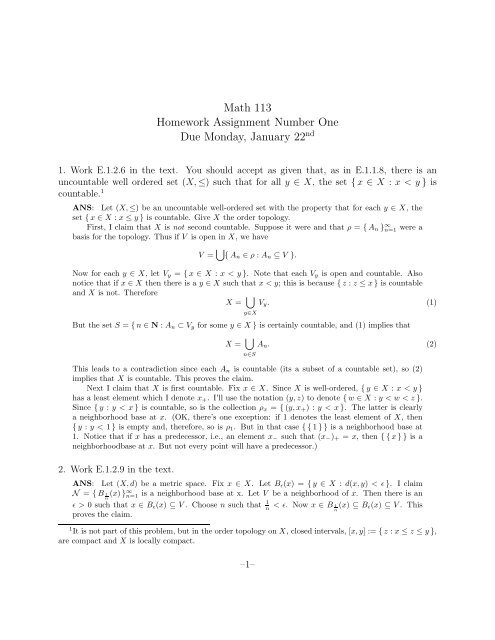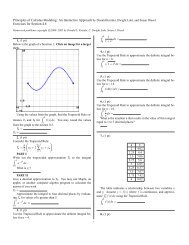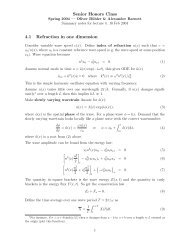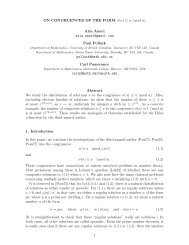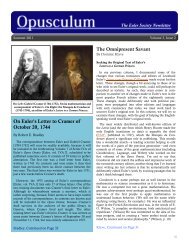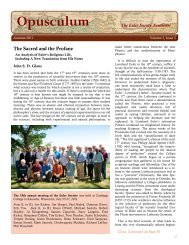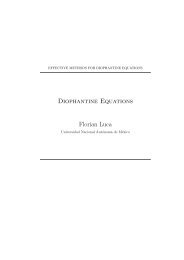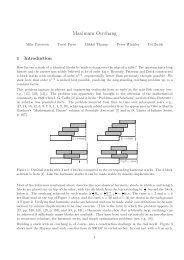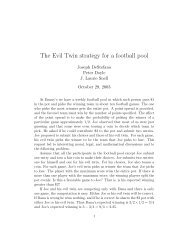Math 113 Homework Assignment Number One Due Monday ...
Math 113 Homework Assignment Number One Due Monday ...
Math 113 Homework Assignment Number One Due Monday ...
You also want an ePaper? Increase the reach of your titles
YUMPU automatically turns print PDFs into web optimized ePapers that Google loves.
<strong>Math</strong> <strong>113</strong><br />
<strong>Homework</strong> <strong>Assignment</strong> <strong>Number</strong> <strong>One</strong><br />
<strong>Due</strong> <strong>Monday</strong>, January 22 nd<br />
1. Work E.1.2.6 in the text. You should accept as given that, as in E.1.1.8, there is an<br />
uncountable well ordered set (X, ≤) such that for all y ∈ X, the set { x ∈ X : x < y } is<br />
countable. 1<br />
ANS: Let (X, ≤) be an uncountable well-ordered set with the property that for each y ∈ X, the<br />
set { x ∈ X : x ≤ y } is countable. Give X the order topology.<br />
First, I claim that X is not second countable. Suppose it were and that ρ = { An } ∞ n=1 were a<br />
basis for the topology. Thus if V is open in X, we have<br />
V = � { An ∈ ρ : An ⊆ V }.<br />
Now for each y ∈ X, let Vy = { x ∈ X : x < y }. Note that each Vy is open and countable. Also<br />
notice that if x ∈ X then there is a y ∈ X such that x < y; this is because { z : z ≤ x } is countable<br />
and X is not. Therefore<br />
X = �<br />
Vy. (1)<br />
y∈X<br />
But the set S = { n ∈ N : An ⊂ Vy for some y ∈ X } is certainly countable, and (1) implies that<br />
X = �<br />
An. (2)<br />
n∈S<br />
This leads to a contradiction since each An is countable (its a subset of a countable set), so (2)<br />
implies that X is countable. This proves the claim.<br />
Next I claim that X is first countable. Fix x ∈ X. Since X is well-ordered, { y ∈ X : x < y }<br />
has a least element which I denote x+. I’ll use the notation (y, z) to denote { w ∈ X : y < w < z }.<br />
Since { y : y < x } is countable, so is the collection ρx = { (y, x+) : y < x }. The latter is clearly<br />
a neighborhood base at x. (OK, there’s one exception: if 1 denotes the least element of X, then<br />
{ y : y < 1 } is empty and, therefore, so is ρ1. But in that case { { 1 } } is a neighborhood base at<br />
1. Notice that if x has a predecessor, i.e., an element x− such that (x−)+ = x, then { { x } } is a<br />
neighborhoodbase at x. But not every point will have a predecessor.)<br />
2. Work E.1.2.9 in the text.<br />
ANS: Let (X, d) be a metric space. Fix x ∈ X. Let Bǫ(x) = { y ∈ X : d(x, y) < ǫ }. I claim<br />
N = { B 1<br />
n (x) }∞n=1 is a neighborhood base at x. Let V be a neighborhood of x. Then there is an<br />
ǫ > 0 such that x ∈ Bǫ(x) ⊆ V . Choose n such that 1<br />
n < ǫ. Now x ∈ B 1<br />
n (x) ⊆ Bǫ(x) ⊆ V . This<br />
proves the claim.<br />
1 It is not part of this problem, but in the order topology on X, closed intervals, [x, y] := { z : x ≤ z ≤ y },<br />
are compact and X is locally compact.<br />
–1–
Next suppose that (X, d) is second countable; let { An } ∞ n=1<br />
each n ≥ 1, choose any xn ∈ An. I claim that D = { xn } ∞ n=1 is dense in X, and hence, that X<br />
is separable. But if V is a nonempty open subset of X, say x ∈ V , then there is a n such that<br />
x ∈ An ⊂ V . Thus, D ∩ V �= ∅. The claim follows.<br />
Now suppose that (X, d) is separable; suppose that D = { xn } ∞ n=1<br />
be a basis for the topology. For<br />
is dense. Let ρ = { B 1<br />
m (xn) :<br />
n, m ≥ 1 }. I will show that ρ is a basis and then it follows by definition that X must be second<br />
countable. Let V be open in X and suppose that x ∈ V . Then there exists ǫ > 0 such that<br />
Bǫ(x) ⊆ V . Choose m so that 1 ǫ<br />
m < 2 . Since D is dense, there is a xn such that d(xn, x) < 1<br />
m . Then<br />
< ǫ. Thus,<br />
if y ∈ B 1<br />
m (xn), we have d(y, x) ≤ d(y, xn) + d(xn, x) < 1<br />
m<br />
This establishes the claim.<br />
3. Work E.2.1.1 in the text.<br />
+ 1<br />
m<br />
x ∈ B 1<br />
m (xn) ⊆ Bǫ(x) ⊆ V.<br />
ANS: The interesting part of this problem is to show that “absolute convergence implies convergence”<br />
implies completeness.<br />
Suppose that { xn } ∞ n=1 is a Cauchy sequence. We accept that it suffices to show that { xn } ∞ n=1<br />
has a convergent subsequence. Using the definition of Cauchy sequence, an induction argument<br />
shows that there is a subsequence { xnk }∞k=1 such that<br />
�xnk+1<br />
1<br />
− xnk� < .<br />
2k Let y1 := xn1, and if k ≥ 2, let yk := xnk+1 − xnk . Then � yk is absolutely convergent. By<br />
assumption, there is a x ∈ X such that<br />
That’s what we wanted.<br />
4. Work E.2.1.4 in the text.<br />
x = lim k<br />
k�<br />
yi = lim xnk<br />
k .<br />
i=1<br />
5. Let X be a normed vector space and let B = { x ∈ X : �x� ≤ 1 } be the unit ball. Show<br />
that if B is compact, then X is finite dimensional. 2 Since this is E.2.1.3 in the text, I was<br />
embarrassed not to be able to give a “qucik” proof. You can either follow my steps below,<br />
or provide a better proof yourself.<br />
2 It is easy to go from here to showing that any normed vector space that is locally compact is necessarily<br />
finite dimensional.<br />
–2–
(a) Let V = { x ∈ X : �x� < 1 } be the open unit ball. Show that there is a finite set<br />
{ x1, . . .,xn } ⊂ X such that<br />
n�<br />
B ⊂ xi + 1<br />
2 V.<br />
i=1<br />
(b) Let Y = span{ x1, . . .,xn } and conclude that<br />
V ⊂ Y + 1<br />
2 V<br />
(c) Let q : X → X/Y be the quotient map. Show that W := q(V ) is open.<br />
(d) Show that 2W ⊂ W.<br />
(e) Deduce that X/Y = { 0 } so that X = Y is finite dimensional as claimed.<br />
ANS: Actually, Chor’s solution was a bit cleaner than mine. (Well, his idea was cleaner, his<br />
execution left a bit to the imagination.)<br />
Once you have V ⊂ Y + 1<br />
2<br />
V , we have V ⊂ Y + 1<br />
2<br />
(Y + 1<br />
2<br />
V ⊂ Z := �<br />
(Y + 1<br />
2nV ).<br />
n<br />
1 V ) = Y + 4V . Iterating,<br />
Clearly, Y ⊂ Z. But it z ∈ Z, then there are yn ∈ Y such that �z − yn� < 1<br />
2 n . But then yn → z,<br />
and since Y is closed, z ∈ Y . Thus Z = Y , and we have<br />
V ⊂ Y.<br />
This implies that Y = X. Therefore X is finite dimensional (since Y is).<br />
6. Define two norms � · �1 and � · �2 on a vector space V to be equivalent in they determine<br />
the same topology on V . Prove that � · �1 and � · �2 are equivalent if and only if there are<br />
nonzero positive constants c and d such that<br />
c�v�1 ≤ �v�2 ≤ d�v�1 for all v ∈ V .<br />
ANS: This is similar to a result proved in lecture. Let T be the identity map from (V, � · �1) →<br />
(V, � · �2). If the norms are equivalent, then T is continuous and therefore bounded. Hence there is<br />
a d ≥ 0 such that �x�2 = �Tx�2 ≤ d�x�1 for all x. Since � · �2 is a norm, d > 0. Since T −1 is also<br />
continuous, there is a c > 0 such that �x�1 ≤ 1<br />
c �x�2 for all x. This is what we wanted to prove.<br />
If the norm inequalities hold, then T and T −1 are bounded maps — therefore they are continuous<br />
with respect to the topologies induced by the norms. In other words, the identity map is a<br />
homeomorphism. Therefore the topologies coincide.<br />
–3–
7. Work E.2.1.11 in the text. CORRECTION: Assume X and Y are Banach spaces.<br />
ANS: We need X and Y to be Banach spaces.<br />
Let X0 = span{ xj : j ∈ J }. Suppose that there is a α ∈ R such that for every finite set λ ⊂ J,<br />
we have �<br />
�� � � �<br />
� �<br />
� ≤ α�<br />
� �<br />
�<br />
�. (3)<br />
j∈λ<br />
αjyj<br />
Since �<br />
j∈λ αjxj is a typical element of X0, we want to define T0 : X0 → Y by<br />
�� �<br />
= �<br />
αjyj. (4)<br />
T0<br />
j∈λ<br />
αjxj<br />
j∈λ<br />
j∈λ<br />
αjxj<br />
But to do this properly, that is, to see that T0 is “well-defined”, we need to see that if<br />
�<br />
αjxj = �<br />
βixi,<br />
j∈λ<br />
i∈λ ′<br />
then �<br />
αjyj = �<br />
βiyi.<br />
j∈λ<br />
To see this, it suffices to see that �<br />
j∈λ αjxj = 0, then �<br />
j∈λ αjyj = 0. But this follows easily from<br />
(3). Therefore we get a well-defined operator T0 : X0 → Y , and (3) implies that T0 is bounded by<br />
α. Then Proposition 2.1.11 implies that there is a T : X → Y extending T0. Clearly T(xj) = yj.<br />
The other direction is straightforward.<br />
8. (After <strong>Monday</strong>’s lecture): Suppose that X is a locally compact Hausdorff space. Show<br />
that C0(X) is closed in C b (X) and that Cc(X) is dense in C0(X).<br />
ANS: Suppose that fn → f with each fn ∈ C0(X). We want to see that f ∈ C0(X). Fix ǫ > 0. It<br />
suffices to see that<br />
{ x : |f(x)| ≥ ǫ }<br />
is compact. Since it is clearly closed, it is enough to see that it is contained in a compact set. But<br />
we can choose n such that �f − fn�∞ < ǫ/2. Then<br />
i∈λ ′<br />
{ x : |f(x)| ≥ ǫ } ⊂ { x : |fn(x)| ≥ ǫ/2 }.<br />
Since the latter is compact, this suffices to show that C0(X) is closed in C b (X).<br />
To see that Cc(X) is dense in C0(X), let f ∈ C0(X). Fix ǫ > 0. Then by assumption,<br />
K := { x : |f(x)| ≥ ǫ }<br />
is compact. By the version of Urysohn’s lemma we proved in lecture, there is a continuous function<br />
φ : X → [0, 1] with compact support such that φ(x) = 1 for all x ∈ K. Since φ ∈ Cc(X), so is the<br />
pointwise product φf. But<br />
�f − φf�∞ ≤ ǫ<br />
(since |f(x) − φ(x)f(x)| = (1 − φ(x))|f(x)| ≤ |f(x)|). This suffices.<br />
Remark. I thought E.2.1.6, E.2.1.8, E.2.1.9 and E.2.1.10 all illustrated some interesting<br />
examples of Banach spaces, but I couldn’t bear the thought of more to grade.<br />
–4–


